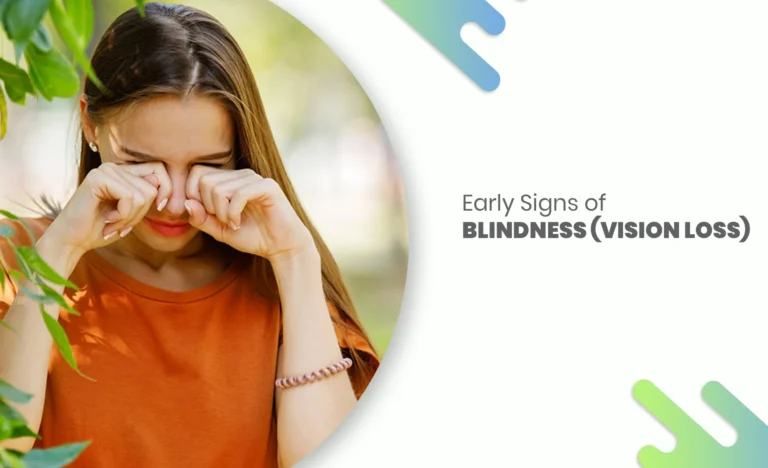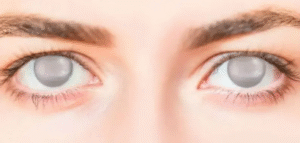Early Signs of Blindness (Vision loss)

Vision is one of the most vital senses, and even subtle changes in eyesight can signal the beginning stages of blindness. Many people ignore early blindness symptoms, such as blurred vision, difficulty focusing, or night blindness, until the condition progresses. Detecting the onset of visual deterioration early can help slow down or even prevent permanent vision loss.

Recognizing vision loss warning signs, like peripheral vision loss, halos around lights, or sudden double vision is essential for timely treatment. These initial vision impairments may be linked to conditions such as macular degeneration symptoms, glaucoma early signs, diabetic retinopathy, or cataracts progression. In some cases, optic nerve damage or rare disorders like retinitis pigmentosa can also contribute.
Since age-related vision loss and other eye conditions can affect daily life, causing reading difficulties, driving vision problems, depth perception issues, or headaches from vision issues, early detection and care are critical. Understanding these progressive blindness indicators empowers individuals to know when to see an eye doctor for vision changes and take steps to preserve long-term eye health awareness.
In some cases, early intervention may involve medications to manage underlying conditions affecting vision. Products like Iverheal 12mg are sometimes prescribed to address systemic infections or complications that could indirectly impact eye health.
What is Blindness and Vision Loss?
Blindness refers to the complete loss of sight, whereas vision loss describes a spectrum of conditions where visual ability is reduced. This can range from mild visual acuity decline to severe partial blindness, where daily activities like reading, driving, or recognizing faces become difficult. The meaning of vision loss often includes challenges linked to tunnel vision, blind spots, or gradual color vision changes.
Globally, the World Health Organization reports that more than 2.2 billion people experience some form of visual impairment, with many cases related to preventable or treatable conditions. Common causes include age-related vision loss, cataracts progression, glaucoma early signs, macular degeneration symptoms, diabetic retinopathy, and optic nerve damage. Rare conditions such as retinitis pigmentosa can also lead to the onset of visual deterioration.
Understanding the definition of blindness and recognizing that the beginning stages of blindness often develop gradually is crucial. Awareness helps individuals notice progressive blindness indicators early, seek medical attention, and protect long-term eye health awareness.
Common Early Signs of Blindness

The symptoms of blindness often begin subtly, making them easy to overlook. Some of the most common early blindness indicators include:
- Blurred vision or cloudy eyesight, which may suggest visual acuity decline or early cataracts progression.
- Difficulty seeing at night (night blindness), a frequent sign of retinitis pigmentosa or age-related vision loss.
- A frequent need to change prescription glasses, which can point to progressive blindness indicators caused by diabetic retinopathy or macular degeneration symptoms.
- Loss of peripheral vision (also called tunnel vision), often linked to glaucoma or optic nerve damage.
- Seeing halos around lights, eye floaters, or flashes of light, which may signal retinal degeneration or other visual field defects.
- Episodes of double vision, color vision changes, or difficulty focusing, which may interfere with daily activities and cause headaches from vision issues.
Because these vision problems can progress gradually, many people adapt without realizing their eyesight is deteriorating. Recognizing these warning signs early is essential to protect vision and maintain independence in reading, driving, mobility, and other daily tasks.
Causes of Vision Loss
There are many causes of blindness, ranging from age-related conditions to underlying medical problems. Some of the most common eye diseases leading to vision loss include:
- Age-related macular degeneration (AMD): A leading cause of visual acuity decline and macular degeneration symptoms, resulting in central vision loss that makes reading and recognizing faces difficult.
- Glaucoma: Often called the “silent thief of sight,” it causes optic nerve damage and gradual peripheral vision loss or tunnel vision.
- Diabetic retinopathy: High blood sugar damages the retina, leading to blurred vision, eye floaters, visual field defects, and even complete blindness if untreated.
- Cataracts progression: A cloudy lens causes cloudy vision, halos around lights, and increased light sensitivity, which worsen over time.
- Eye injuries or infections: Trauma, untreated infections, or corneal scarring can trigger onset of visual deterioration and, in severe cases, permanent blindness.
- Retinal degeneration and retinitis pigmentosa: Rare but serious conditions that often begin with night blindness and progress to significant visual impairment.
While most vision loss arises from chronic conditions such as glaucoma or diabetic retinopathy, certain infections or parasites can also contribute. In such cases, treatments including Iverheal 12mg may be recommended to prevent further optic nerve damage or retinal degeneration.
When to See a Doctor
Knowing when to see an eye doctor can make the difference between temporary vision issues and long-term sight loss. Certain urgent eye symptoms should never be ignored, including:
- Sudden vision changes, such as blind spots, tunnel vision, or rapid visual acuity decline.
- Eye pain accompanied by light sensitivity, headaches from vision issues, or swelling.
- Episodes of double vision, difficulty focusing, or noticeable color vision changes.
- Sudden appearance of eye floaters, flashes of light, or expanding visual field defects, which may indicate retinal degeneration or detachment.
- Rapid progression of blurred vision or worsening night blindness, which can signal glaucoma early signs, diabetic retinopathy, or cataracts progression.
Even in the absence of red flags, the importance of regular eye checkups cannot be overstated. Routine exams help detect progressive blindness indicators and manage conditions like macular degeneration symptoms or optic nerve damage before permanent vision loss occurs.
Timely care ensures better management of age-related vision loss, reduces mobility challenges, and protects long-term eye health.
Prevention and Early Management
While some causes of blindness are unavoidable, many cases can be delayed or reduced with proper care. Adopting healthy habits and following proven eye care tips are key steps to prevent vision loss.
- Lifestyle habits for eye health: A nutrient-rich diet high in leafy greens, omega-3s, and antioxidants supports the retina and slows age-related vision loss. Limiting screen time reduces eye strain and headaches from vision issues, while wearing sunglasses provides UV protection against cataract progression and macular degeneration symptoms.
- Regular screenings: Routine eye exams are crucial for early detection of progressive blindness indicators such as glaucoma, diabetic retinopathy, and retinal degeneration. These checkups help identify visual acuity decline, color vision changes, or visual field defects before they become irreversible.
- Managing underlying conditions: Controlling chronic issues like diabetes and hypertension can significantly reduce the risk of optic nerve damage and other eye diseases leading to vision loss.
Early blindness prevention is about more than protecting sight, it preserves independence, reduces mobility challenges, and supports long-term eye health awareness. Alongside lifestyle habits and regular screenings, addressing infections early with medications like Iverheal 12mg can reduce risks that may exacerbate progressive blindness indicators.
Conclusion
Recognizing the early blindness signs, such as blurred vision, night blindness, tunnel vision, or sudden visual acuity decline is the first step in protecting long-term sight. Many of these progressive blindness indicators begin subtly, but timely care can make all the difference.
By following preventive measures like maintaining healthy habits, managing conditions such as diabetes or hypertension, and scheduling regular eye exams, individuals can significantly lower their risk of age-related vision loss, cataracts progression, or optic nerve damage.
The key to vision health care lies in awareness and action. If you notice changes like double vision, halos around lights, or persistent difficulty focusing, don’t delay, consult an eye specialist. Taking early steps to protect eyesight ensures a better quality of life, independence in daily activities, and long-term eye health awareness.
FAQs
1. What are the first warning signs of blindness?
The early blindness signs include blurred vision, night blindness, frequent need to change glasses, peripheral vision loss (tunnel vision), eye floaters, and halos around lights. These progressive blindness indicators often appear gradually, so regular checkups are essential.
2. Can vision loss be prevented?
In many cases, yes. Following eye care tips such as eating a healthy diet, wearing UV protection, limiting screen time, and having regular eye exams can help prevent vision loss. Managing conditions like diabetes, hypertension, and glaucoma early signs is also crucial for blindness prevention.
3. Is blurry vision always a sign of blindness?
Not always. Blurred vision may result from temporary issues like eye strain or dehydration. However, persistent blurriness can signal cataracts progression, macular degeneration symptoms, or diabetic retinopathy, and should be checked by an eye doctor.
4. What eye diseases most commonly cause blindness?
The leading eye diseases causing vision loss include age-related macular degeneration, glaucoma, diabetic retinopathy, cataracts, and retinal degeneration conditions such as retinitis pigmentosa. Early detection helps slow progression.
5. When should I see an eye doctor for vision changes?
Seek medical help immediately if you notice sudden vision changes, double vision, blind spots, or flashes of light. Even mild visual acuity decline or color vision changes should prompt an eye exam, as these may be early signs of more serious vision health problems.


